Automated Creation of TIA Portal Projects for Complex Machine Setups
Introduction
The automated creation of TIA Portal projects is made possible by the Modular Application Creator, which relies on pretested software modules. This approach significantly improves efficiency, particularly in complex machine setups such as multi-belt control or multi-axis applications, reducing the need for manual creation and parameterization of the automation project within the Siemens TIA Portal software.
The Modular Application Creator or MAC comprises the following elements: the MAC software and equipment modules. While each package operates independently, they require a connection between them.

Prerequisites
What you will need to follow along with this tutorial:
- The TIA Portal and StartDrive should be installed on your computer. While version 18 is used in this tutorial, it is worth noting that versions 16 and 17 of the mentioned software are also compatible.
Download and Initial Startup
What is the first step to employ the Modular Application Creator? Well, it is necessary to download the all-in-one package of the Modular Application Creator for TIA Portal version 18 from here, version 17 from here, and version 16 from here. Subsequently, extract the contents of the file into a different directory.
To begin using the software, double-click the ModularApplicationCreator.exe file provided within the download package for the Modular Application Creator.
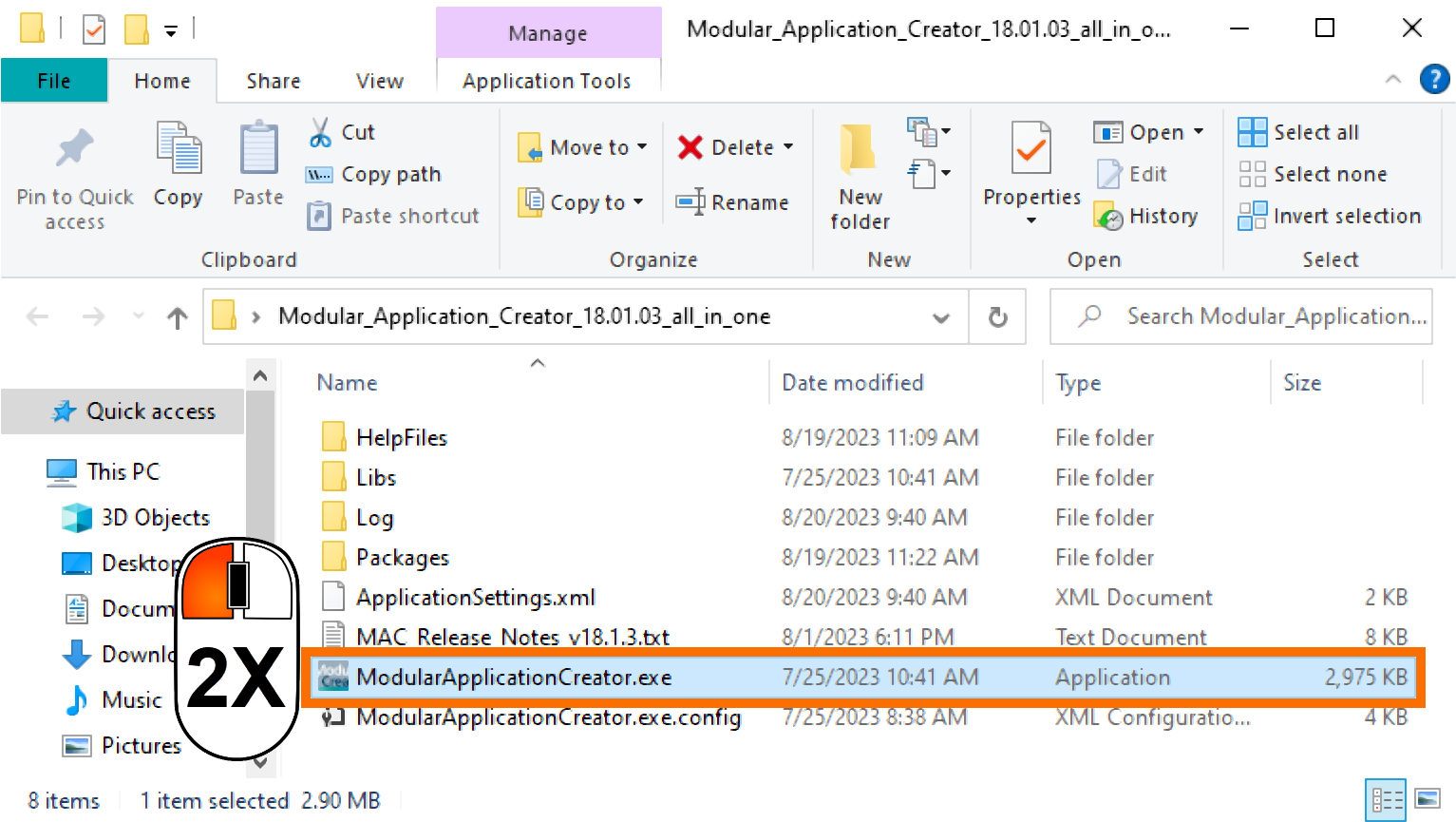
At the beginning, a legal disclaimer with essential information is presented. In the upper part, you can switch the language of the text among the available language options.
Take a moment to carefully read and confirm your acceptance of all the terms and conditions provided by checking the checkboxes located at the bottom. Press Accept to proceed further.
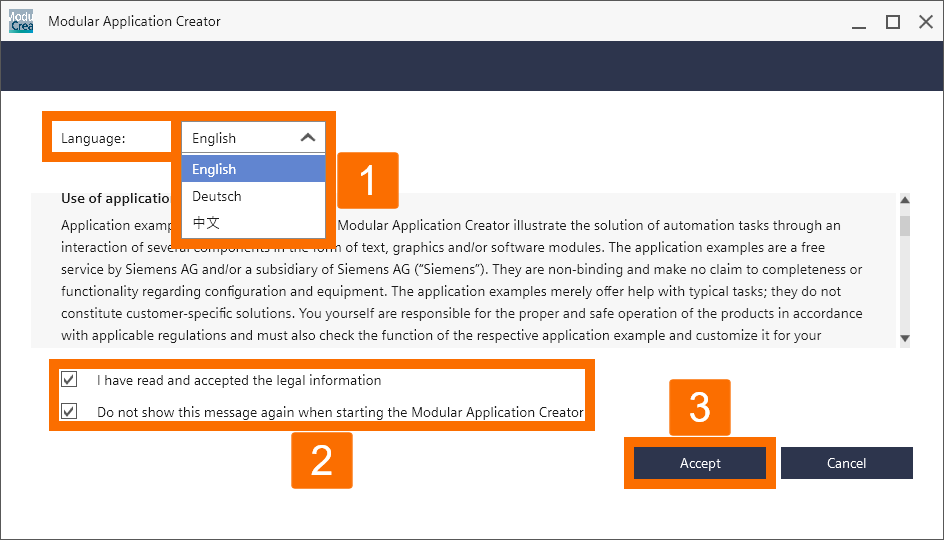
The proper functioning of the Modular Application Creator relies on establishing a link with the equipment modules. To accomplish this task, access the Settings menu, find the Source section, and specify the location where the equipment modules are placed.

Choose the directory containing the equipment modules from the extracted all-in-one download located in the Packages folder.

Build the Initial Project
As the software starts, a blank screen displays, giving the user two choices: opening a preexisting Modular Application Creator project or establishing a new one.
Select the Create new project option to start building the initial MAC project. Subsequently, it can be initiated using any TIA Portal project built on version 18 or, for a smoother first attempt, with a preconfigured project template provided in the module package. With this in mind, opt for the second choice.
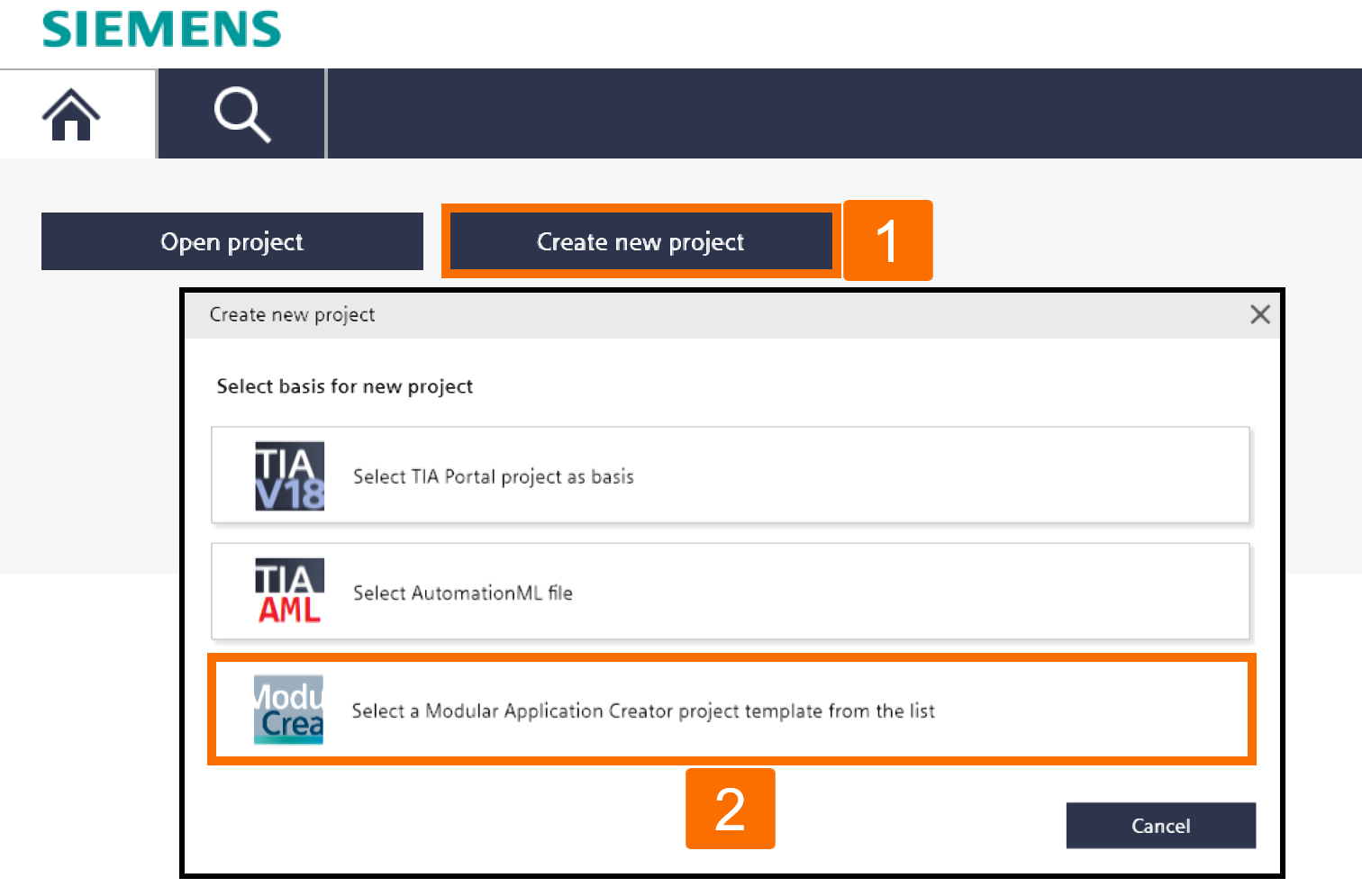
Afterward, a window will be displayed, presenting a list of the provided project templates for selection. When an entry is chosen, further details about the template will be shown on the right-hand side.
Before initiating the formation of a new MAC project, input a descriptive name for the project and designate a preferred location for storage. To close the window and directly open the new project, press the button Create and Open.
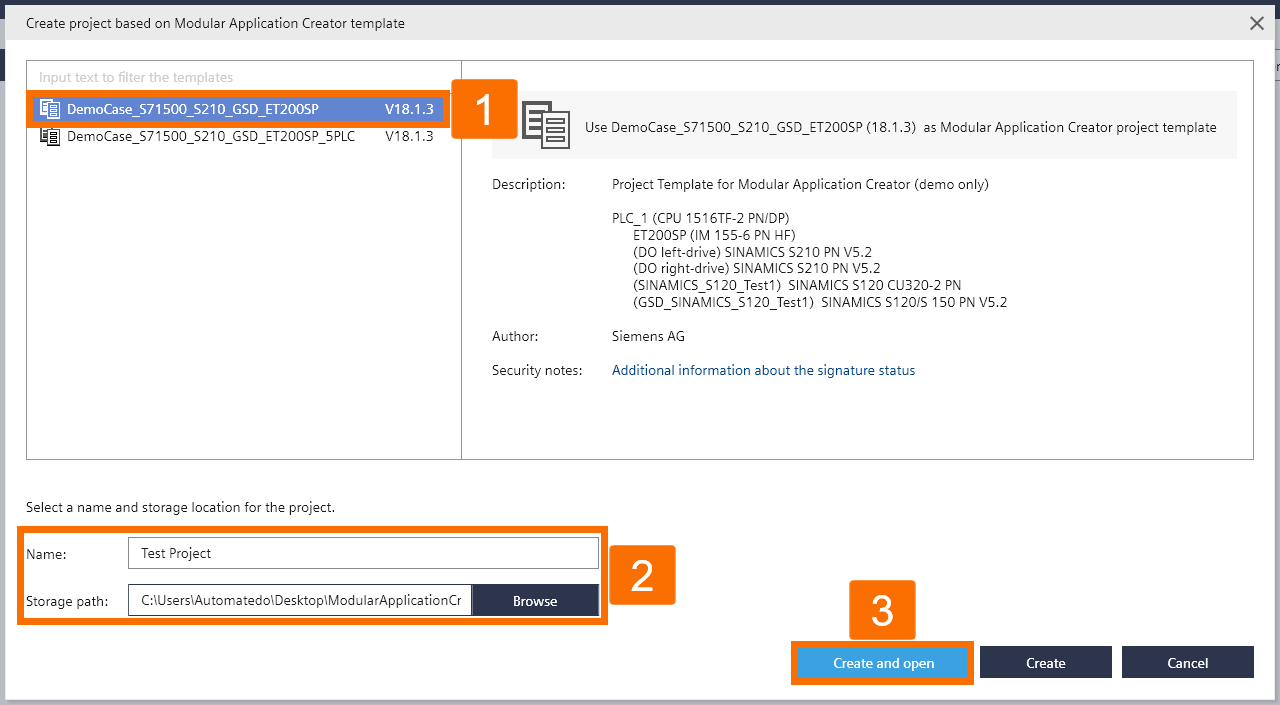
Pick an Equipment Module and Incorporate It into the Project
Progressing to the next step, the selection of modules and their assignment to a PLC are essential. Once the button Create and Open is selected, the project will open immediately, revealing the subsequent screen. The left side of the interface provides a view of the PLC available in the TIA Portal project being used. While in the middle, you can find all the equipment modules identified by the software within the initially specified folder.
When you select a module, the lower section of the screen provides supplementary information related to the chosen module. Select, for example, the Intelligent Belt module to incorporate it into the ongoing workflow. This module allows for the control of multiple belts.

For the module to be functional, assign it to the designated PLC within the TIA Portal project, where it will be generated. The module assignment can be accomplished through drag-and-drop action or by right-clicking over the module and selecting Add to PLC.
During the module assignment, the system runs a compatibility check to determine if the module can be used with the chosen PLC, considering aspects like the need for a Technology PLC. Performing this initial validation aids in identifying compatibility issues beforehand, thus preventing the execution of a non-functional generation.
Once the module is linked to the PLC, provide a purposeful name for this particular module. This name plays a crucial role in the generation process. Also, it directly affects the resulting code and associated resources.
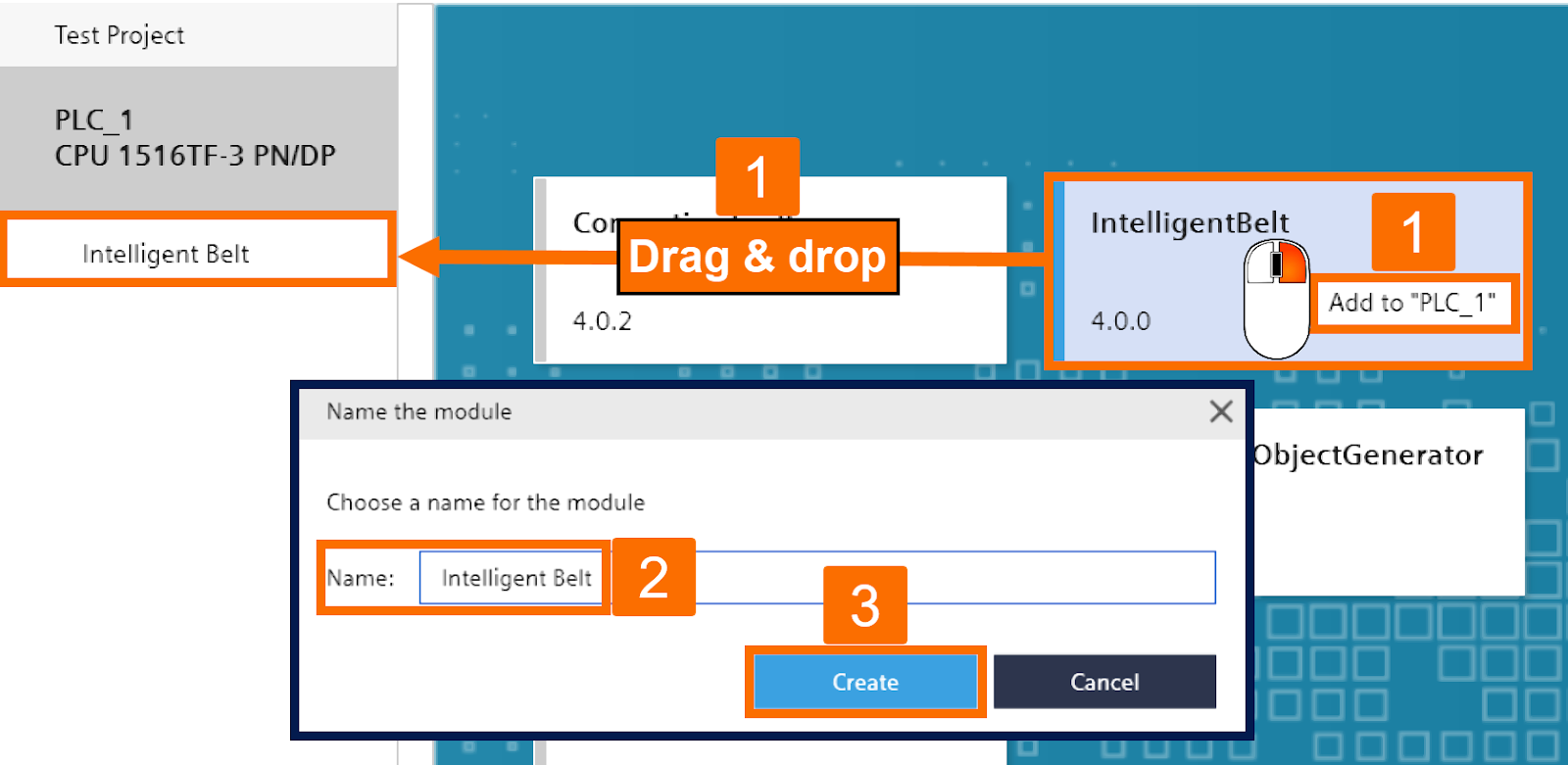
Customize an Equipment Module’s Configuration
After assigning the module to a PLC, it becomes possible to configure it meticulously, considering specific parameters. To accomplish this, choose the module and access the configuration mode by either double-clicking over it or selecting the Configure Modules button in the software's header.
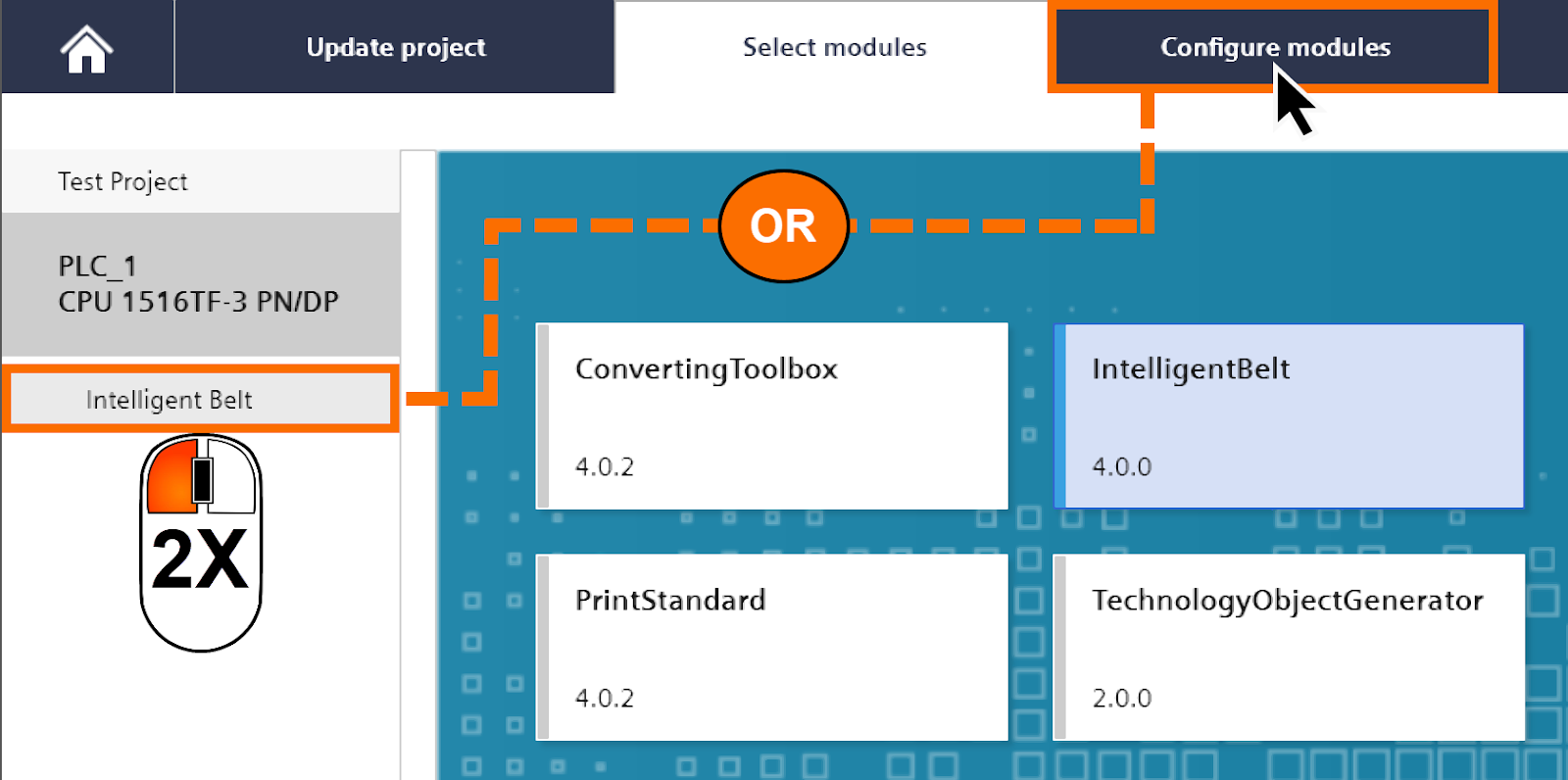
In turn, the screens that appear are tailored to each equipment module, offering technological insights grounded in each module's unique characteristics. In the configuration interface, there might be multiple pages, and you can seamlessly navigate through them by accessing the internal tabs positioned at the top or by utilizing the Forward and Back buttons provided at the bottom.
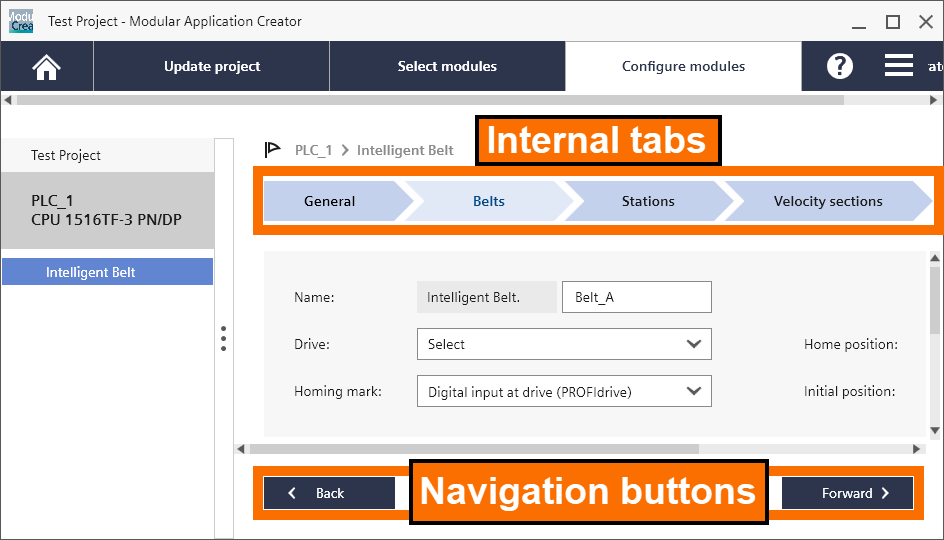
In the process of creating a TIA Portal project that is deemed valid, the initial step involves assigning names to the two axes, followed by the selection of the respective drives, and finally, the adjustment of specific values. The values provided undergo an internal validation process to ensure they fall within acceptable limits and to identify any incorrect entries. Take a chance and see for yourself!
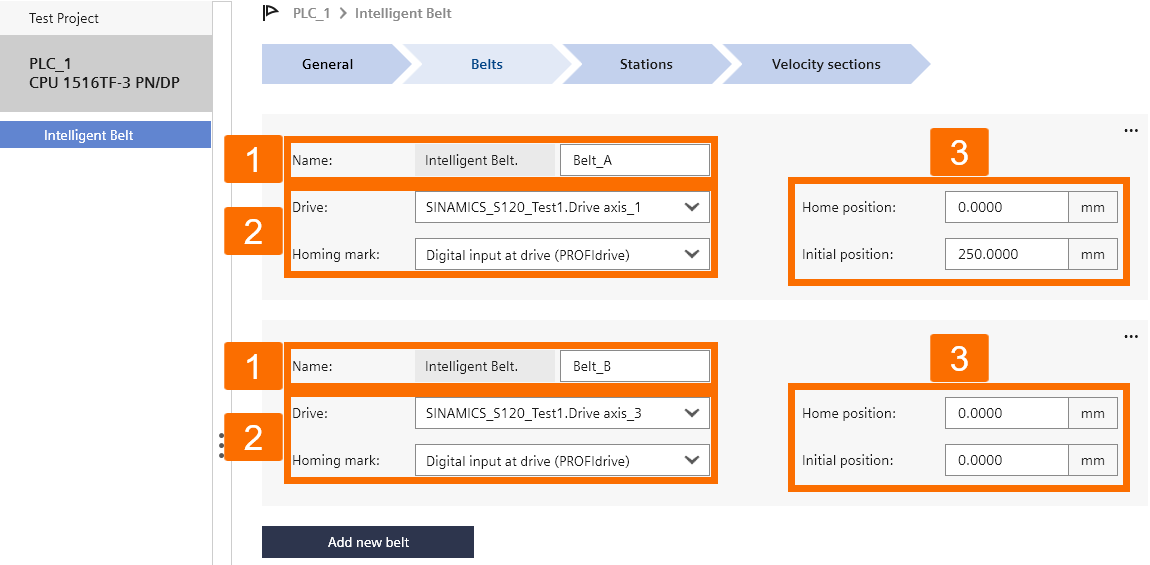
The equipment modules are equipped with online resources that offer assistance and information on the underlying technology. By clicking the "?" button or hitting the F1 key, users can activate the help window, which grants access to assistance. These actions also provide access to the help content dedicated to the tool itself.
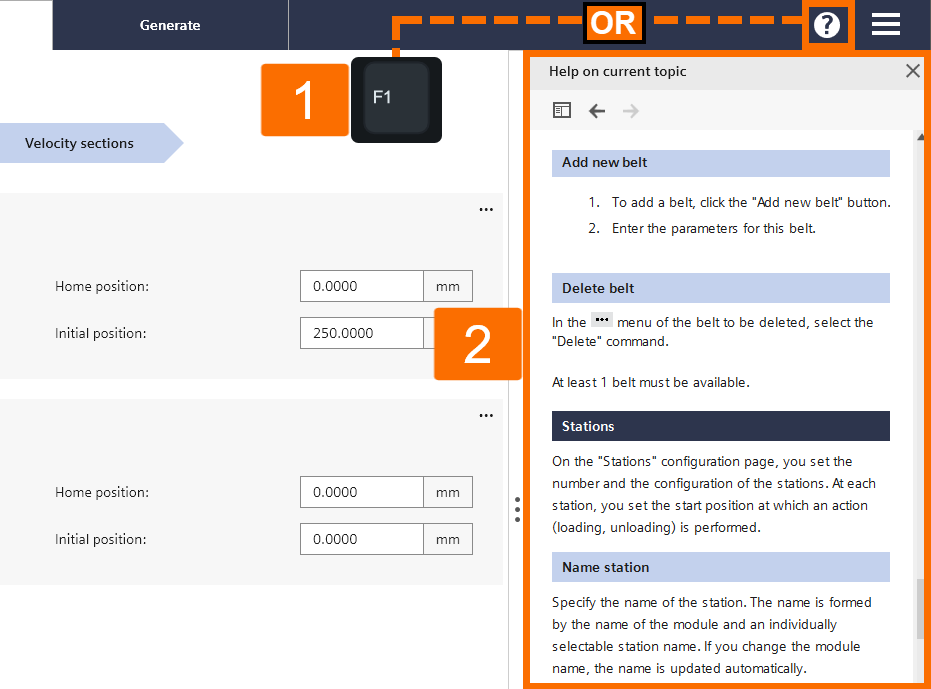
It's worth mentioning that any configurations you make will be automatically saved in the project files. It means you can switch seamlessly between modules or screens or even close and reopen the project later without concern about losing your data.
Following the configuration of all data, the final step involves starting the generation of the TIA Portal project, which commences the process that will deliver the resulting project as intended.
Formulating a TIA Portal Project in Alignment with Given Specifications
For this task, you must open the generation page by clicking over the Generate tab in the software's navigation headline.
It is imperative to have TIA Portal V18 and StartDrive V18 installed, ensuring that the Openness Interface is activated for both software to carry out a generation process. If you want to gain an understanding of this matter, please refer to this article and read through pages 31 to 36.
Within the Advanced Settings, you can input a comment for the TIA Portal project and make modifications to the generation scope. It empowers you to selectively exclude specific PLCs or modules from the creation process, tailoring it to your needs.
Initiate the creation process into TIA Portal by pressing the Generate button. Please note that the generation process may require a few minutes, but you can track the progress in the EventLog that will appear shortly.
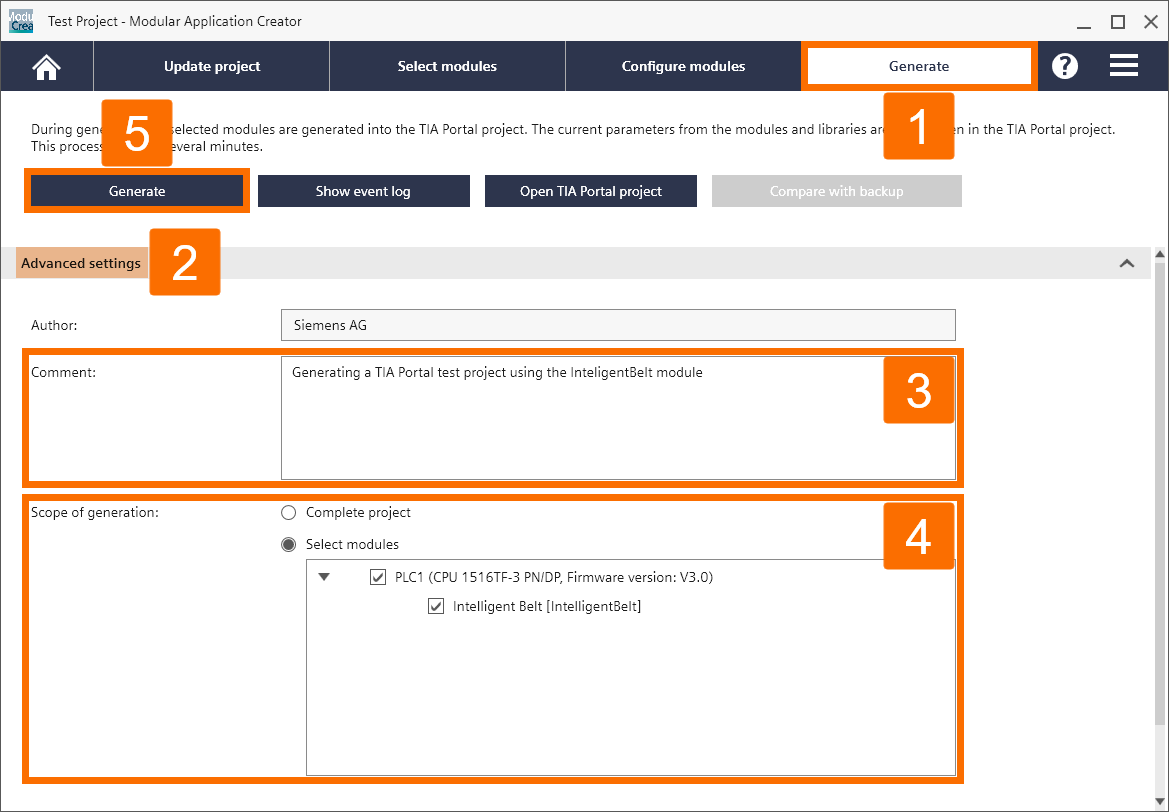
While the generation process is underway, an event log window will be displayed, providing real-time updates and logging various status information. It is important to note that the software will be in a modal mode during this time, which means it will be inoperable until the generation process is either halted or completed.
If you haven't performed this action earlier, the Openness firewall dialog associated with the Openness interface of the TIA Portal will automatically pop up and require explicit acceptance to commence the generation process.
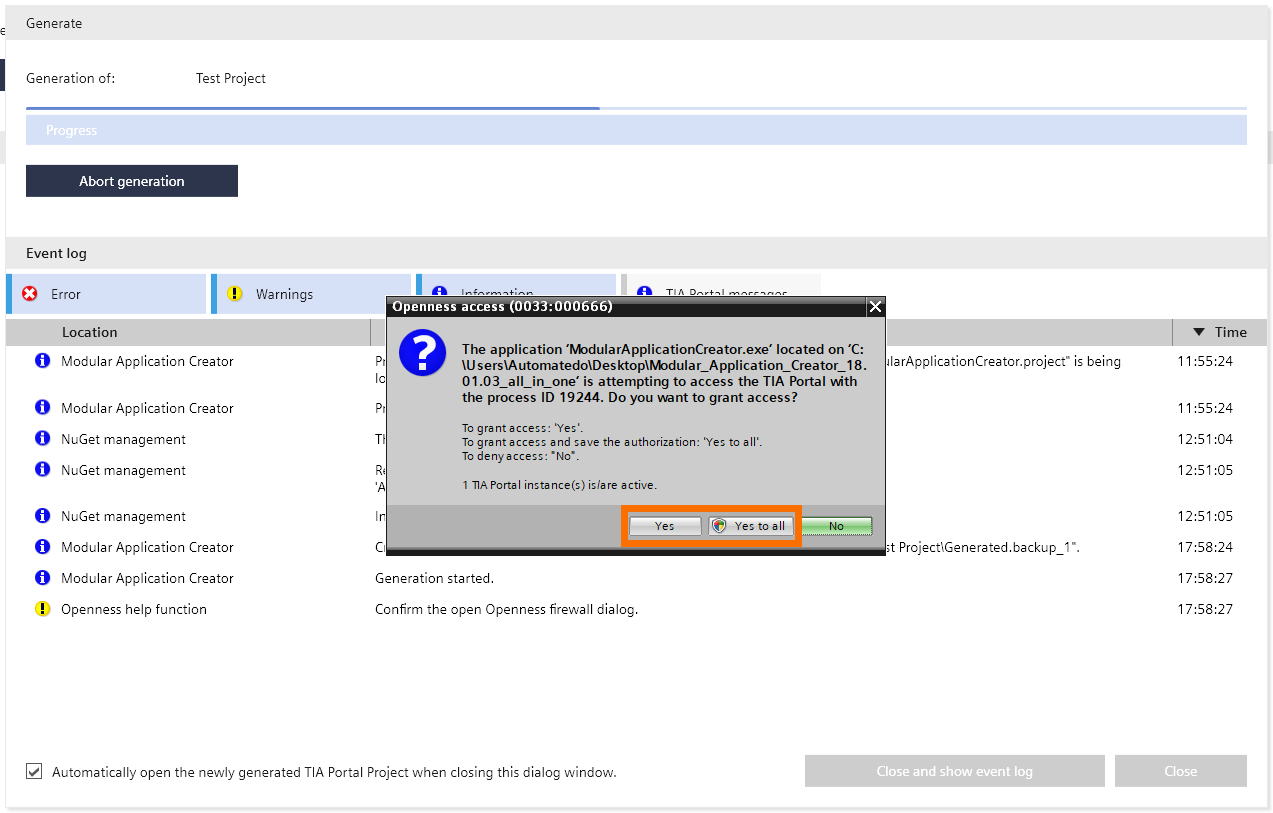
Once the generation process is complete, you can directly open the TIA Portal project by checking the checkbox in the lower-left corner of the event log window. Alternatively, you can press the Open TIA Portal Project button on the main page to access the project afterward.
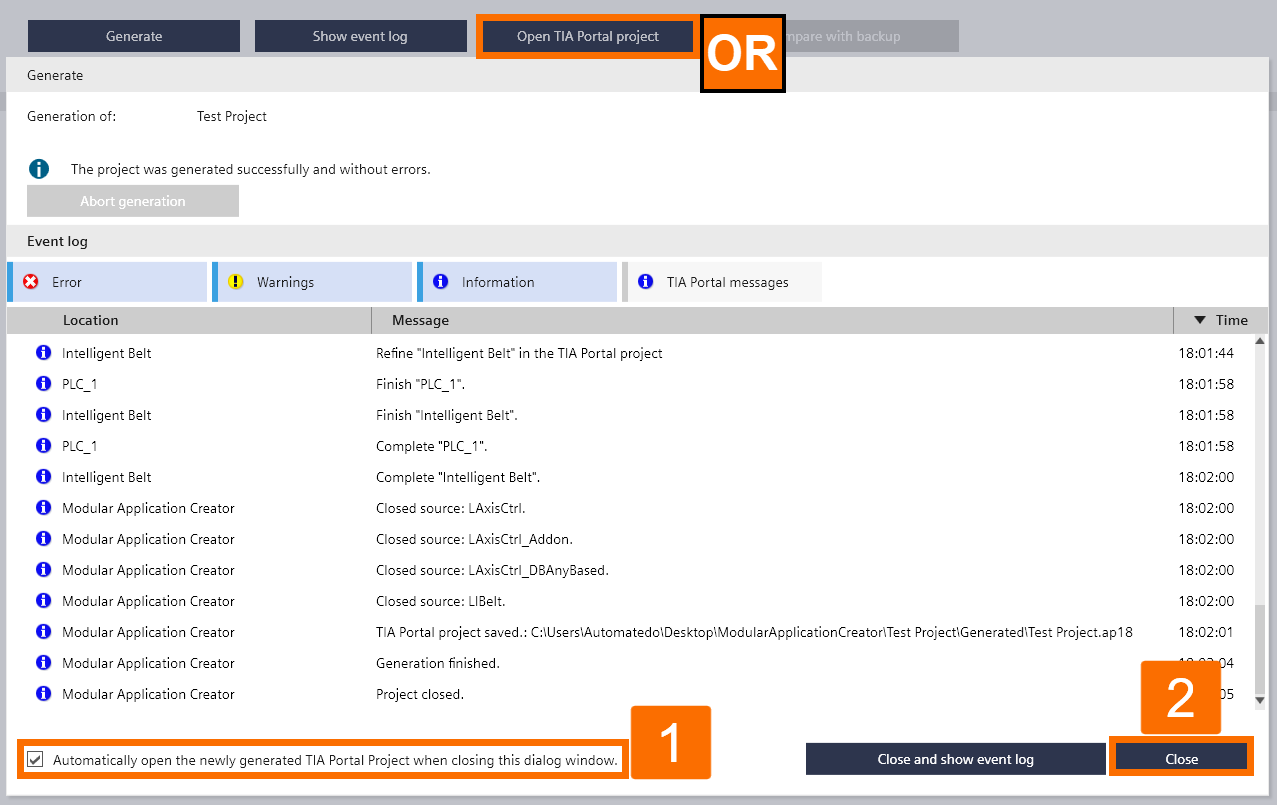
Review the Created TIA Portal Project
Upon opening the TIA Portal project, you will discover that all the generated objects are readily available. These objects consist of libraries, the generated module group comprising instance data blocks, and even the technology objects with their corresponding configured parameters from the Modular Application Creator.
The project is now ready for compilation and can be downloaded to either the actual PLC or the PLCSIM for testing purposes. When operating the generated software on industrial machinery, it is essential to possess a specific license.

Conclusion
In conclusion, you learned by leveraging the Modular Application Creator and its utilization of pretested software modules, the automated creation of TIA Portal projects becomes possible. You understood how to download the Modular Application Creator and go through its initial startup. You figured out how to create the initial MAC project. You grasped how to pick an equipment module to incorporate into the project and customize its configuration. You became acquainted with formulating a TIA Portal project in alignment with the given specifications. And finally, you learned how to review the generated TIA Portal project.


